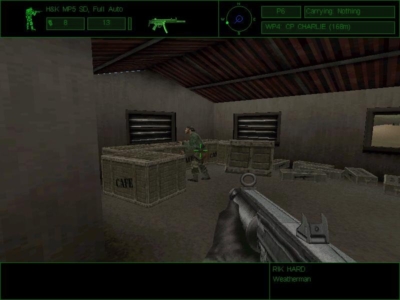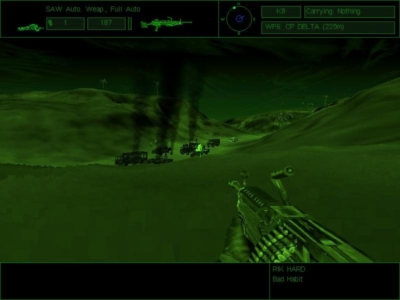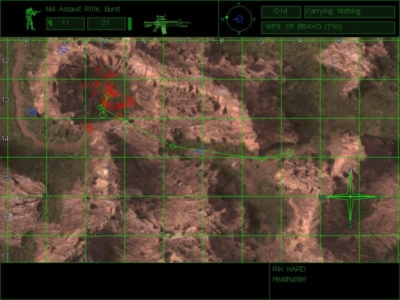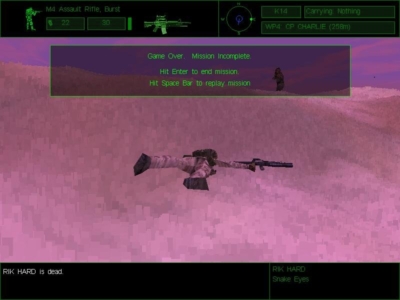
Delta Force
Written by: Discussion
Date posted: September 2, 2012
- Genre: Action
- Developed by: Novalogic
- Published by: Novalogic
- Year released: 1998
- Our score: 6
Hello there. This is a discussion review, a semi-recent, semi-regular event on FFG, which involves one of us choosing a game and both of us playing it, before we meet up for a discussion of our findings.
This time around, Stoo did the choosing, opting for the tactical shooter Delta Force. Developed by Novalogic, previously best-known for producing tank and flight sims (most famously, the helicopter-based Comanche: Maximum Overkill), and released to moderate acclaim, the game represented a diversion from the usual FPS fare, and garnered a significant following, boosted by a variety of multiplayer modes (which, incidentally, we tried to test out for the purposes of this review, but failed completely).
That’ll leave me, the other one, as the host of today’s discussion, which follows:
Alpha 1 is down
Rik: Okay, then, we’ll start with the obvious: what prompted you to pick out Delta Force for discussion?
Stoo: Well, we’ve covered a lot of first-person shooters from the 90s, but Delta Force was one of the first to attempt a realistic depiction of modern warfare. So, there are large open maps, firefights can take place over distances of few hundred metres, and you die in a couple of hits. It was rather different to the standard shooter template of the time, ie Quake 2.
Rik: Any prior experience of the game before this?
Stoo: Nope.
Rik: Me neither. In fact, in my ignorance, I had assumed some kind of tactical/squad control element, prompting memories of something like Hidden and Dangerous, which I found impossibly difficult and fiddly. Thankfully, though, there’s none of that overarching control, you just take care of your own player.
Stoo: Yep that element is definitely downplayed. You’re more like a lone gun with allies who do their own thing (to varying levels of usefulness).
Rik: It’s quite odd, that. You don’t come across your fellow soldiers all that often. You’re told you’re part of a bigger operation, but how much you feel a part of that team is open to debate. You follow the plan outlined on the briefing, but you don’t really communicate or coordinate with the other forces.
Stoo: They’re usually waiting on the other side of the map. They might provide fire support, or get themselves killed. I would have liked at least a “get over here and help me!” command.
Rik: What happens to them doesn’t seem to matter all that much, it seems to me. I accidentally shot a member of Alpha Team, and no-one seemed to care.
Stoo: “Alpha 1 is down!”
Rik: “Really? Poor guy *whistles*”
Stoo: The last map I did required me to be right inside an enemy base before they triggered, which seemed fairly suicidal, so they basically sat the whole mission out.
Rik: Is it fair to say you can largely ignore your colleagues in this game?
Stoo: They can help, a bit, when they’re in the right place, but I never really counted on them being around to save my ass in a firefight.
Rik: They seem to go about their business regardless of your actions. And you go about yours regardless of theirs. So from that perspective, anyone expecting to be part of a well-oiled military machine is going to be disappointed. But, for others for whom squad control and complex commands are likely to be off-putting, it’s probably a plus (speaking as someone for whom that applies).
Stoo: I’d be mostly worried about getting them killed anyway. Having to take care of friendlies always stresses me out, it makes you feel like you fail when they die, even if you make the objectives anyway.
There’s no feeling gung-ho and invincible
Rik: Let’s call that a positive, then. But it doesn’t mean that this is a mindless FPS.
Stoo: Indeed. You have to be fairly careful; enemies will engage you from a long way off, and if you stand around in the open you’ll get gunned down quite fast.
Rik: I thought one of the main things in its favour was the way it managed to recreate the feeling of standing in the middle of the desert with the possibility of everything going wrong very quickly.
Stoo: Yep, when you have bullets pinging all around you, and you think, “oh hell, now what do I do?”
Rik: There’s no feeling gung-ho and invincible. If you take a shot, you’d better know where it came from, otherwise you’ll be dead quite quickly.
Stoo: I frequently found myself pinned down somewhere with constant fire overhead, and you have to either risk popping your head out to take a shot, or just run for it, or… stay stuck there forever.
Rik: We should also point out there’s no cowardly quicksave either.
Stoo: Just to keep things in perspective though, I went in worried it would be like Operation Flashpoint which kicked the crap out of me from the first map. Delta Force, on the early maps and normal difficulty, is not *that* brutal – you just have to be careful.
Rik: The AI is quite ropey. Which kind of balances out the otherwise realistic ‘one shot, one kill’ approach to make it manageable.
Stoo: Enemies are a fairly poor shot. Also, I once got outflanked by a guy who then decided to lie prone and fire his rifle into a bump in the ground two feet in front of him. Sort of wasted his chance at an easy kill.
Rik: They don’t seem that observant. It’s quite easy to pick them off from a position where you think, “they must be able to see me from here”.
Stoo: It helps that it’s quite easy to shoot straight. I’ve a feeling the weapon modelling (ie ballistics of bullets) isn’t as fancy as in Flashpoint, so I could sometimes pick off baddies at leisure while they shot around me. Although later I went to another campaign on higher difficulty, and I’m not sure which factor was making the difference, but it did feel more intense. Guys were happily gunning me down from 200m away if I was dumb enough to get in their field of view.
Rik: Hm, so maybe it gets tougher later on. I only played through the first couple of campaigns. In some of the missions I played, I felt that lots of enemies were just sat around in tents oblivious to what was happening. Although I suppose you could make a case for that being a legitimate tactic when you’re losing a gunfight – wait for them to come to you.
Stoo: There seem to be some with eagle eyes, and some stood facing a corner of their tent – a bit of a mixed bag.
Rik: I think in general, indoors isn’t handled all that well. There was one mission which involved me venturing into a house, where everyone was just standing around staring the wrong way. But I still nearly messed it up because the engine couldn’t hack it very well and started going slightly choppy.
Stoo: Visual distortions?
Rik: No, just a feeling that the engine wasn’t designed for that kind of thing.
Stoo: Fortunately there’s not a lot of indoor action.
Volumetric Pixels
Rik: I guess at this stage we should mention the voxels…
Stoo: Haha yes! Good choice, or not, in your opinion?
Rik: It’s actually very good at creating those sprawling hilly landscapes, and to be fair it isn’t as blocky and murky as I expected, but it falls down in places, like when you try crawling, or any time you have to go inside. Although it’s unrealistic, I actually felt the bullet trails were quite helpful when trying to track where you’re being shot at from, and also tracking your own shots, but the general soupiness of it all does mean you struggle to pick out any details of anyone you’re shooting, which makes it necessary for the game to highlight friendly fire for you.
Stoo: I think it’s good for natural-looking terrain. At the time polygon-based engines could only give fairly hard and flat landscapes – here you have proper hills, gulleys, ridges etc. The problem is the pixellation…
Rik: It’s probably quite a good representation of the real thing – shooting blurry shapes on the horizon. In practical terms, I had some trouble during a mission when we needed to take an enemy alive and I shot him, because how could you pick him out?
Stoo: The soupiness is worse in night missions I found – kept mixing up baddies and small shrubs or oil cans, because everything is in night-vision monochrome.
Rik: Yep, I kept shooting trees and whatnot…
Stoo: I think overall I’m a fan of voxels, in the context of late-90s gaming. Outcast used them quite effectively also.
Rik: They’re fine really. They probably have aged better than polygons of similar vintage.
Bravo is en-route to the LZ
Rik: How did you feel about the missions, and the single-player campaign in general?
Stoo: Well, a lot come down to “clear enemy base”, with varying levels of difficulty. Some are meant to be stealthy, but I never really tried that approach. Then you’ve got “stop a convoy” type ones, which are more high pressure as you can’t creep around taking your time.
Rik: There was one mission where you had to creep around and follow a convoy without being spotted, and only attacking at a certain point. I found it quite annoying spending ten minutes or so getting to the mark without getting in trouble, only to die or mess it up once the shooting began.
Stoo: I think I missed that one. But certainly, having to do some tense lengthy segment, only to cock up and restart from scratch, can be draining.
Rik: Also, sometimes the requirement to ‘kill all enemies’ can be an arse. There was one mission when I’d secured the main objective, and the only enemy soldier was miles away, but I had to go trawling across the hills to finish him off before I could complete the mission.
Stoo: I generally try to circle around and kill outliers first – of course someone might later go for a wander anyway.
Rik: The waypoint system did make it feel a bit like a flight sim…
Stoo: The waypoints can be suicidal sometimes.
Rik: They seem to involve you staggering into the open to get shot.
Stoo: They can be the direct path, when you’re better off finding some high ground to snipe from. Unfortunately, as mentioned earlier, you might need to hit a waypoint for your allies to trigger.
Rik: Although there is an overarching campaign, it does feel like a succession of individual missions. You seem very far removed from what’s happening. That’s what I meant by it seeming like a flight sim – you kind of go to the waypoints and do your bit, then you get some text saying, “thanks to you doing your job, we won the war.”
Stoo: Heh, yes it is all quite drily presented.
Rik: I guess it all fits in with what they’re going for. And the alternative is some ridiculous Rambo effort like Soldier of Fortune, but for me it meant that the usual motivation to continue was slightly lacking.
Stoo: Yep, it is pretty much just a string of separate missions in varying locations, with varying over-the-top shouts from the baddies.
Rik: I liked it enough to play for a while, but not to battle my way through to the end. It does recreate that nervous isolation of the battlefield, stripped of most of the gung-ho bollocks you see in Call of Duty, or whatever. But it also lacks that narrative edge to keep you playing.
Stoo: Well, I guess military games have gone in two directions: the cinematic one like Call of Duty and the soldier-sims…
Rik: And this is a soldier sim. I guess it might have been more interesting in co-op, had we been able to get it working.
Stoo: Yep I don’t know if we’re incompetent or what…we got as far as tinkering with routers and still no luck. But anyway, I think a game like this can still have more of a compelling narrative. Delta Force isn’t particularly interested in such things, it’s just about the military scenarios for you to try out.
Rik: Even without turning it too much into nonsense, they could have done something like a series of news reports as the campaign progressed, just indicating the general situation. Anyway, it’s not to be.
Closing remarks
Rik: Anything else you want to mention?
Stoo: We mentioned AI earlier, it did look like baddies were somehow magically turning to track me despite being on the other side of a hill. Which felt a bit cheaty. Oh also, did you end up taking the M4 every mission? It seems the best all-round weapon by a wide margin.
Rik: I followed your advice, yes. It turned out to be good advice, thanks to the scope and burst fire combo.
Stoo: Also it’s fun shooting grenades into tents and hearing 3 screams of AIEEEE at once.
Rik: I forgot to mention, why do they give you the option to replay a successful mission? With the press of a button you could very easily hit accidentally?
Stoo: Oh I did that once by mistake…
Rik: Anything else?
Stoo: No vehicles. None you can use, that is. Just to compare with Operation Flashpoint again, which lets you drive pretty much anything you see.
Rik: I have a feeling it would have made for plenty of ‘jeep stuck on hill’ type scenarios.
Stoo: Heh, possibly. Also the focus of the game is special-ops, who tend to not go trundling around in tanks. Still, some ability to ride around in trucks, jeeps etc is a feature I’d expect from a modern game of this sort.
Rik: You mentioned Operation Flashpoint a couple of times: how does this compare?
Stoo: More limited, but more accessible. Flashpoint made me ragequit, which I’m not proud of…
Rik: I found Delta Force more accessible than I was expecting. Definitely not one to scare people off.
Stoo: Yep. Anyone generally competent in shooters can make some progress and enjoy playing Special Forces guy. On the flipside, if you are a hardcore Flashpoint fan, this might feel a bit too simple or arcadeish.
Rik: So, cautious recommendation, then?
Stoo: I’d go one step higher. Erm, moderate recommendation?
Rik: I was for 2.5-3 blobs. Do you suggest higher?
Stoo: Let’s go for 3. [Edit: 3 blobs now equates to a score of 6].
Rik: Okeydokey. Well, that probably does it then.






 Posts
Posts